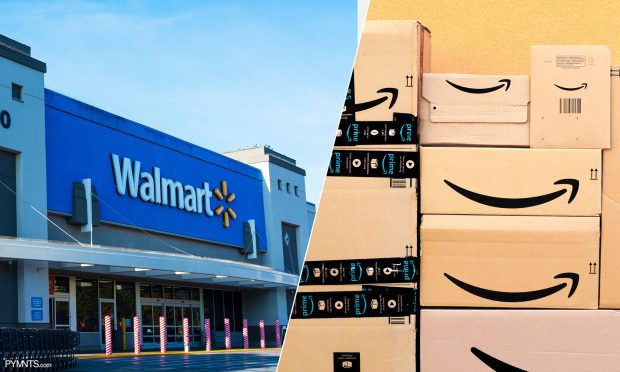Is Amazon or Walmart the Retail Industry’s Recessionary Winner?

Now that Amazon has delivered its mixed fourth-quarter earnings results, the focus has shifted to Walmart, which is set to report its Q4 earnings Feb. 21 in what could be an inverse outcome of what its rival just booked.
Where the eCommerce giant delivered 9% top-line growth for the year and quarter, the Arkansas-based operator of 11,000 physical stores is pegged by analysts to deliver about half as much top-line growth.
On the bottom line, however, while Walmart’s Q4 and full year earnings per share are expected to slip a bit from last year, the retail giant — unlike its rival — is still pegged to deliver a hugely profitable set of results.
This top- versus bottom-line performance dichotomy has set up a debate, not only over which of the two retail giants is the better operator, but which business and stock performs better in a good or bad economic climate.
“We’ve seen that during periods of economic uncertainty, consumers are very careful about how they allocate their resources and where they choose to spend their money,” Amazon Chief Financial Officer Brian Olsavsky told investors on the company’s Q4 earnings call Thursday (Feb. 2). “Throughout Amazon’s history, we have found that our focus on the customer helps to set us apart in times like these.”
For Walmart, the self-titled low-cost leader frequently notes that it has been through many peak-to-trough economic cycles over its 60-year history where it has done very well with customers in need of bargains. While that original retail footprint and supercenter model still exists, albeit in scaled form, CEO Doug McMillon recently told an investor conference that running the current Walmart is a bit like running three different businesses.
“Sometimes I visualize it as three P&Ls. There’s the original retail P&L, and then there are the new things we’re building,” McMillon said in December at a Morgan Stanley industry event, pointing to the company’s efforts to grow gross merchandise value (GMV), marketplace, advertising and membership.
In the beginning, that new P&L loses money, he said, because you’re building it out, “but eventually, it’s better than the first P&L, so you put them together, and you get a third one, and that’s our new business model, and that’s what we’re trying to build.”
Growing Pains vs Long-Term Gains
To be sure, Walmart isn’t the only one trying out new things and investing in change, as reflected in Amazon CEO Andy Jassy’s reiteration on the company’s earnings call that the hangover from its massive and unprecedented build-out during COVID-19 will likely linger for another year.
Jassy said the company’s simultaneous doubling of its fulfillment center footprint, which had taken 25 years to build, plus the creation of a last-mile transportation network the size of UPS — in only a few years — “took everything we had.”
But now that it is built and in place, the 27-year company veteran and former lead of the Amazon Web Services unit told investors the work now would be in finding and extracting new efficiencies and cost reductions within its “maniacal” focus on customer experience.
“We exist to make customers’ lives better and easier every day and to relentlessly invent to do so,” Jassy said on the call, noting that “speed” is going to be a top priority for the business. “We believe that continuing to get products to customers faster makes customers happier, and they also convert at a higher rate when they can see promises of deliveries that are faster.”
For its part, Walmart is equally invested in long-term transformation while navigating short-term challenges, as evidenced by its triple P&L mindset. Even so, the trajectory of these retail businesses and the performance of their respective stock prices is often disconnected and reflective of different realities and expectations.
In the short term, the market momentum has shifted back to Amazon’s favor, as its shares are up over 25% so far this year, versus a flat performance by Walmart, which itself is lagging a 7% gain for the S&P 500.
On a 12-month basis, however, while shares of Walmart are still flat, that compares positively to the 9% decline for the benchmark index and the 25% slump in the value of Amazon.
For Walmart, the challenge two weeks from now will be finding a way to convince investors that it can also lead — or at least keep up — with Amazon in an improving economy.
For all PYMNTS retail coverage, subscribe to the daily Retail Newsletter.
